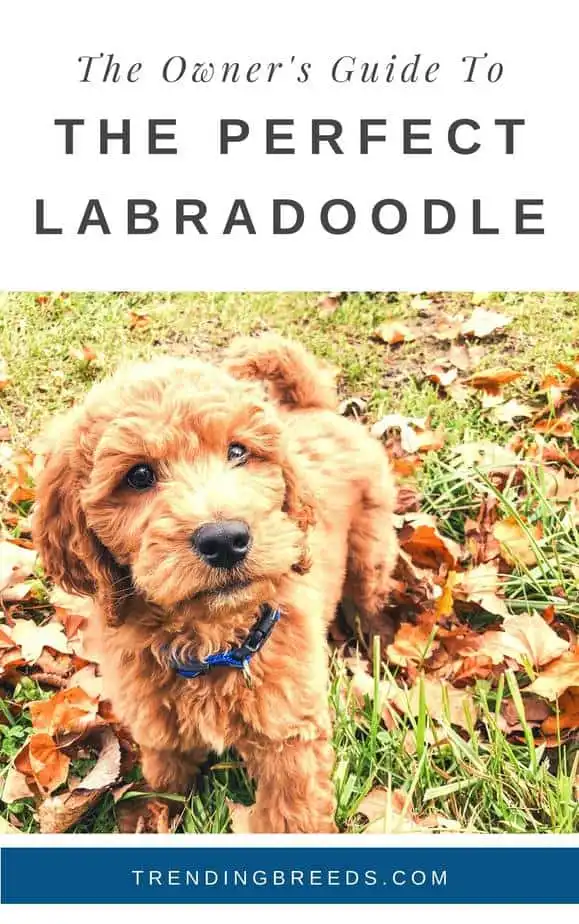
The Labradoodle is one of the most in-demand of the crossbreeds and known for being one of the original designer dogs.
They were first bred during the late 1980s by Wally Conron, an Australian breeder seeking a suitable guide dog for a woman whose husband was allergic to dogs.
After a lot of trial and error, Conron successfully bred his finest female Labrador Retriever and a Standard Poodle and created the first Labradoodle.
The breeding process has since evolved, allowing various sizes and coat colors to emerge.
What sizes do Labradoodles come in? Today, there are 4 size varieties of Labradoodles that we commonly see: Petite/Micro, Miniature, Medium, and Standard. They range from under 1 foot at the shoulder and under 10 pounds, to over 2 feet at the shoulder and 75+ Pounds. We’re going to cover the sizes and nuances of each later on, but here are the size and weight ranges for each.
| Height | Weight | |
| Petite or Micro | 10 to 13 inches at the shoulder | 8 to 15 pounds |
| Miniature | 16 to 16 inches at the shoulder | 15 to 25 pounds |
| Medium | 17 to 20 inches at the shoulder | 30 to 45 pounds |
| Standard | 21 to 24 inches at the shoulder | 45 to 75 pounds |
Are you seriously considering adding a Labradoodle to your life? You certainly won’t be disappointed, but you shouldn’t go into it blindly.
Educating yourself about things like working with a breeder, temperament, training, and grooming is really one of the best things you can do for your dog.
Our latest book, The Owner’s Guide To The Perfect Labradoodle, gives you tons of practical, easy-to-apply advice and tips that I’ve learned over the years while raising my two Labradoodles.
Really, this book covers it all:
- Breeders.
- Adoption.
- Puppy proofing and socialization.
- Housebreaking and obedience training.
- Nutrition and health.
- Exercise and mental stimulation.
- Grooming.
- And much more.
You won’t find a more honest look at the breed and more useful information anywhere else.
The Breeding Process
The breeding process for the Labradoodle involves breeding a Poodle and a Labrador Retriever. The Labradoodle has DNA from the Labrador Retriever and Poodle breeds.
The different sizes of Labradoodles are produced by breeding Poodles and Labrador Retrievers of various sizes.
As an owner of 2 Labradoodles myself, I know how tough it can be to find good information. In the 60+ pages of this book, I share the information, resources, and breed-specific tips I wish I’d had from the start. You will save you time, money, and loads of frustration…take my word for it!
What Is A Multi-Generational Labradoodle?
Multi-Generational Labradoodles are the puppies born from five consecutive breedings and whose parents are both an F3 generation or higher.
This selective breeding process helps breeders achieve litters of puppies with the traits and characteristics they are looking for.
With Labradoodles, one of those desired traits is a low-shedding coat.
Generational breeding terms are often used by breeders. Here are some of you will likely encounter when researching Labradoodles:
- F1 is a first generation Labradoodle, which are 50% Labrador and 50% Poodle, are bred from purebred Labrador Retrievers and Poodles.
- F1b is a first generation (F1) Labradoodle that’s bred to a purebred Poodle. Puppies from F1b litters are 75% Poodle, so they have more of the physical characteristics of that breed. The coat type can vary on an F1b dog. This variety of Labradoodle may have restrictions on size and may still shed somewhat.
- F2 Labradoodle puppies have parents that are both F1. Puppies from the same litter may not all have similar characteristics.
We go more in-depth on the Multi-Generational Doodle, describe the differences between the generations, and explain the advantages of them in this article.
Different Poodle Sizes Used In The Breeding Process
Labradoodles are found in a variety of different sizes. To achieve these various sizes, different sizes of Poodles are bred with Labrador Retrievers.
Toy Poodle Size
The Toy Poodle is the smallest of the breed that’s recognized by the AKC (source).
The White Cuban Dog was the ancestor of the Toy Poodle, a breed of a small, lap dog that arrived in England and Spain from the West Indies.
The breed became such a sensation in France that it became the country’s national dog. Today, the Toy Poodle is the result of breeding the smallest of Miniature Poodles.
Height: Less than 10 inches tall
Weight: 5 to 10 pounds
Miniature Poodle Size
The Miniature Poodle is believed to have originated by crossbreeding Maltese and Hannes dogs to create the smaller toy and miniature breeds.
The Truffle Dog is also in the ancestry of the Miniature Poodle. The Miniature Poodle was used to hunt truffles in England, Germany, and Spain.
They were favored by French nobility and became famous as companions. The breed is recognized as a non-sporting dog by the AKC.
Height: Between 10 and 15 inches tall at the shoulder
Weight: Between 12 and 15 pounds
Standard Poodle Size
The Standard Poodle is the largest and oldest of the breed that the AKC recognizes. The breed originated in Germany as hunting and waterfowl retrieving dog.
The standard clip of standard poodles made it easier for them to swim when retrieving and helped the dog’s joints stay mobile and keep him warm in the winter.
Height: At least 15 inches at the shoulder
Weight: Between 40 and 55 pounds
Different Labradoodle Sizes
There are four varieties of Labradoodles, each with distinct size and weight characteristics.
Keep in mind that the size of each will vary depending on the breeding stock used by different breeders.
However, an experienced and reputable breeder should be able to quite accurately predict the size pups will reach at maturity.
That said, this will help give you a baseline on the various sizes of Labradoodles. When comparing and selecting a breeder to work with be sure to ask them about their specific litters.
We provide you with a list of specific questions to ask the breeder during the screening process so you can be certain you’re dealing with a breeder who truly cares for the dogs.
Petite/Micro Labradoodle Size
You may see them called Petite, Micro, and even Toy depending on the breeder. These are happy, fun-loving pups that are affectionate and easy to train.
Just how easy to train are they? We answer that here.
You might even see them competing in Agility and Competitive Obedience competitions. This size is tougher to find and you’ll likely pay a premium when you do find them.
You’ll find examples of real breeder prices and an explanation of factors that influence pricing in this article.
Height: 10 to 13 inches at the shoulder
Weight: 8 to 15 pounds
Miniature (Mini) Labradoodle Size
Height: 14 to 16 inches at the shoulder
Weight: 15 to 25 pounds
Medium Labradoodle Size
Height: 17 to 20 inches at the shoulder
Weight: 30 to 45 pounds
Standard Labradoodle Size
Height: 21 and 24 inches at the shoulder
Weight: 45 to 75 pounds
Temperament Differences By Labradoodle Size
Although every dog has a different temperament, there are similarities among Labradoodles, depending on the variety of Poodle it’s bred to.
The Petite Labradoodle is an energetic, active dog who is an affectionate dog for any family.
The petite loves to play and have fun with their family but is content to keep herself entertained. However, the Petite Labradoodle loves attention, and is eager to please her owner.
These dogs are friendly and like meeting other people and pets. Petites are extremely intelligent, making them easy to train.
Many Petite Labradoodles are trained to be therapy dogs, though they perform well in a variety of service-dog roles.
Miniature Labradoodles are very friendly and playful. They have a lot of energy and are very social, mainly due to the breeds.
Although Poodles sometimes can be standoffish with strangers while Labradors exude personality, puppies can have dominant traits from either breed.
Labradors can get lonely and have bouts of boredom if they’re left alone too much, so they need a lot of physical and mental stimulation (see our complete guide).
Medium Labradoodles are like the other varieties in that they love to play and spend time with their owners.
These dogs usually behave well, but if they’re kept inside too much, they can become restless and unhappy.
The temperament of Standard Labradoodles depends mainly on the personality of his parents.
In this article, we cover the 5 main personality characteristics found in Labradoodles, which will give you a great idea of why they are so popular.
Since Labradors and Poodles are very social breeds of dog, Labradoodles usually are happy with good dispositions.
These dogs are excellent with children of every age, are enthusiastic, and eager to learn new things.
Characteristics of Labradoodles
Not all Labradoodles look the same.
Since these dogs aren’t currently recognized as a breed by the AKC, there isn’t a breed standard as there is for purebred dogs.
Labradoodles can vary considerably in appearance, size, and temperament.
Labradoodle Coats
Labradoodles have three coat varieties:
- Fleece coats are soft and may be wavy, kinked, or flowing.
- Hair coats may be straight or wavy and have a texture which is similar to a Labrador coat.
- Wool coats are in tight curls, similar in appearance to that of a Poodle, but the coat is softer.
All of the coats do require grooming. So be prepared for some upkeep no matter which you choose.
We give you plenty of tips and let you know what to expect in our Guide to Labradoodle Grooming.
The coat color of Labradoodles depends on their breeding. Since the dogs have the genes of a Poodle, their coats may be a variety of colors.
Here are some of the most commonly seen Labradoodle coat colors:
- Apricot
- Black
- Chalk
- Chocolate
- Coffee
- Cream
- Gold
- Red
- Silver
The dog’s coat may have abstract patches of color including brindle, sable, or white.
Their coats may even bleach out or lighten when they’re out in the sun, which is normal for a breed that’s so active.
Although Labradoodles were initially bred to be hypoallergenic, not all of them have this trait. Some puppies in a litter may be hypoallergenic while others aren’t.
The dogs that do shed tend to shed less than other dog breeds. For an in-depth, honest look at Labradoodle shedding, read this article.
Labradoodles have broad heads, eyes that are expressive, and floppy ears.
These dogs do require frequent grooming, but shouldn’t appear to be overly groomed.
Labradoodles have a lot of energy and require training beginning when they’re puppies, especially for those who are large.
The dogs should have a considerable amount of exercise. Our Labradoodle Exercise Guide covers recommended amounts of exercise and suitable activities for both puppies and adults.
Labradoodles are loyal to their owners but are very friendly, and usually warm up to people they meet for the first time.
Both Labradors and Poodles have distinct characteristics.
Characteristics of Poodles
Poodle Coats
The curly-coated Poodle is an excellent choice to be bred to a Labrador. The dogs are highly intelligent, playful, and friendly.
When bred to be Labradoodles they make a delightful addition to any family. The variety of coat colors of Poodles are influential in the appearance of Labradoodles.
Here are some of the most commonly seen Poodle coat colors:
- Apricot
- Black
- Blue
- Brown
- Cafe Au Lait
- Cream
- Gray
- Red
- White
Do All Breeders Use The Same Parent Breeds?
Although the original Labradoodles were the result of breeding a Labrador with a Poodle, not all breeders rely on the same parent breeds.
The Australian Labradoodle Association has approved several breeds to develop the Labradoodle breed even further, including:
- Labrador
- Poodle (Toy, Miniature, Standard)
- American Cocker Spaniel
- Curly Coat Retriever
- English Cocker Spaniel
- Irish Water Spaniel
Are Cross-Breed Dogs Healthier Than Pure Breeds?
The longevity of a dog breed is an indicator of the health of the breed. Generally speaking, healthy dogs that are crossbred live longer lives than purebred dogs.
When dogs are inbred, the risk of the dogs being carriers of a gene that causes diseases specific to that breed is higher than dogs that are a mix of two or more breeds.
That said, there are a few health issues that unfortunately tend appear in Labradoodles. You can read about them in this article.
What Are the Pros and Cons of Cross Breeds Versus Pure Breeds?
Pure breed dogs are the result of true breeding which means their character and appearance can be predicted from one generation to the next.
However, mixed-breed dogs don’t breed true, which means the character and appearance can vary with each puppy born in a litter.
By contrast, mixed breed puppies generally have more stamina and are healthier than purebred pups.
Another reason that a crossbreed like a Labradoodle is an excellent choice for novice and experienced dog owners is that is the gene pool isn’t as limited as it is with purebred dogs.
When there’s less genetic diversity, litter sizes tend to be smaller, and the survival rate is lower than it is with a mixed-breed litter.
Related Questions:
What is the life expectancy of a Labradoodle?
One of the best things about welcoming a Labradoodle into your home is that they have long lifespans.
The standard Labradoodle can live anywhere from 10 to 15 years old, but some have survived into the late teens.
How much attention do Labradoodles need?
Like all dogs, Labradoodles love attention and companionship, but that doesn’t mean you have to spend all your time playing or going for walks. Labradoodles are always eager to please their owners and enjoy spending time with you.
What care do Labradoodles need?
Before you become a Labradoodle parent, you should find out as much as possible about their care.
Ask your breeder, of course, but also invest in a quality book specific to the breed.
Our Labradoodle ebook walks you through every aspect of care and is filled with tips I’ve learned from my personal experience with these wonderful dogs.
To start your puppy off on the right track, to forge the strongest possible bond, and to be the best owner that you can be, this book is truly a must-have.
Although most dogs have an independent streak, they require their owners to make sure they get lots of love, attention, and excellent care from your veterinarian.
Although all Labradoodles require grooming, (be sure to see the tools we recommend for this breed) some only need to be brushed while others need frequent trips to the groomer.
The more wool-like or curly the Labradoodle’s coat is, the more grooming is required, not only to keep their coat free of tangles and get rid of loose hair but to help keep their skin in good condition.
The Labradoodle’s coat must be brushed several times a week, and thorough brushing is essential.
These dogs have coats that repel water, so if they get muddy, let them get dry, then brush them to remove the dirt.
A slicker brush is ideal for this job. I use this one from Amazon because it releases trapped hair with the press of a button and is perfect for daily use.
Although Labradoodles don’t require frequent baths, occasional bathing is a necessity.
New Labradoodle owners need to know how often their dog should see the vet. The answer is that it depends on the dog’s age and general health.
Puppies need to see the vet every three to four weeks for vaccinations until they’re 16 weeks old. At the age of six months, your Labradoodle can be spayed or neutered.
From the time your Labradoodle reaches maturity at about one year of age, he’ll see the vet once a year for a general wellness checkup.
After the round of vaccinations when they’re puppies, Labradoodles usually have their boost vaccines every three years. However, the time frame for vaccines depends on state law.
A lot of veterinarians now recommend that your dog come in for a checkup every six months once they reach the age of about seven.
Some dogs start to have mobility or other issues, and the veterinarian can prescribe the best treatment to keep your dog healthy and happy.
What kind of food do Labradoodles eat?
Each dog has different tastes and dietary needs. The food you feed your Labradoodle depends on their age, size, and level of activity.
Puppies require food that has the nutrients that help their bones and muscles to develop properly. If you’re going to feed your puppy dry food, check the ingredients list carefully.
(Head over to our Guide to the Best Dog Food to become an expert at label sleuthing.)
The dry dog foods that are the highest quality have some meat or poultry listed as the first ingredient.
You don’t want to buy any food that has any grain listed as the main ingredient, because your puppy will be digesting a lot of fillers instead of food with needed vitamins and minerals.
There are a lot of excellent dry dog foods on the market, like this one featuring sweet potatoes and fish) that are natural and don’t contain any artificial ingredients or fillers.
Closing Thoughts
The popularity of the Labradoodle breed has made for a variety of options when it comes to size and color combinations.
Whether the compact energetic nature of the Petite or the size and versatility of the Standard, there’s a perfect Doodle out there for everyone.





